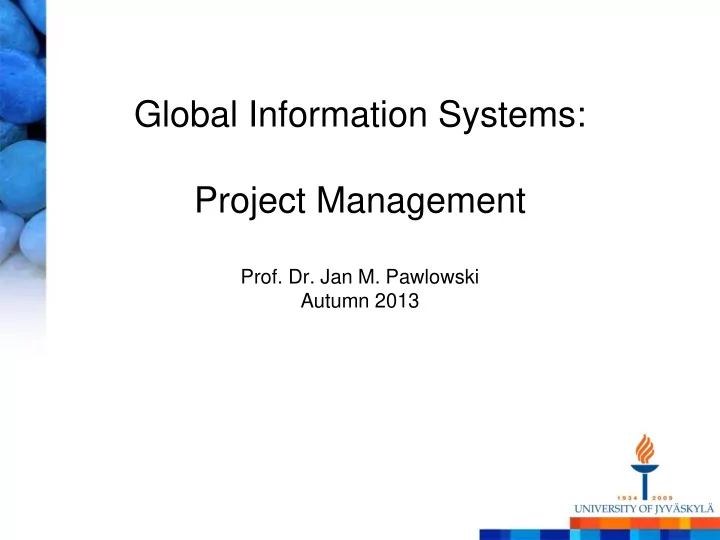

Global Information Systems: Project Management Prof. Dr. Jan M. Pawlowski Autumn 2013
Project Planning Planning of the process – Distribution of actors / organization – Staff selection – Cost estimation – Schedule / workflow – Coordination activities – Communication tools Results – Project plan, workflow, … – Staff plan: roles / competencies / effort – Coordination planning – Supporting tools: Guidelines / rules / standards
Project Planning: Offshore vs. Nearshore “Offshoring” – Assigning (parts of) a knowledge-intensive development process to a geographically remote partner – Cost reduction – Accelerating the production process “Nearshoring” – Assigning (parts of) the development process to a geographically close partner – Possible advantages concerning distance, language, time, culture, politics, …
Project Planning: Offshore vs. Nearshore (Carmel, Abbott, 2006)
Project Planning: Offshore vs. Nearshore Need to analyze and estimate… – Coordination – Cultural misunderstandings – Communication cost – Team building / training cost – Mistakes / prolonged life cycle Findings for India (Carmel, Abbott, 2006) – Nearshore locations provide a politically stable atmosphere – India is a long way away – India is called “distant lands;” difficulties with long distance management and cultural differences – India is too difficult to manage remotely; too many time zones away. Cheaper, real-time communication relative to India. – Nearshore better for outsourcing business-critical work – Nearshore offers lower costs of communication, shipping and tariffs
Project Planning: Cost estimation (Sangwan et al., 2006) Calibrate cost estimation tool Estimate module sizes Allocate modules to development iterations Estimate code size for each iteration Estimate development time, effort and peak staff – Including coordination / communication effort Estimate iteration development time and average team staff size Estimate development schedule time – Including time differences Estimate development cost
Project Planning: Sample coordination activities Instruments to monitor and control the development process (Boland, Fitzgerald, 2004) Single software manager and weekly task reports – Reducing coordination efforts – Tools to assign tasks properly Delivery reports – Awareness – Trust Quarterly synchronisation meetings Informal meetings and instruments
Project Planning: Risk Management Risk: The possibility of suffering a loss (Sangwan et al, 2006) Risk lifecycle – Identify – Analyze – Plan – Track – Control – Communicate Risk in GSD processes – Coordination – Architecture alignment – Uncertainty and change
Risk Management: Identifying risks Organizational aspects / coordination capability – Background and skills – Domain knowledge of teams – Communication / collaboration history – Organizational separation / integration – Shared culture / language Organizational stability
Risk Management: Avoiding risks Monitoring and control Skill improvement and training Unified tool structure Management communication Frequent builds / prototypes Frequent status meetings Cross-team reviews Contingency planning: If something goes wrong…
At the end of this phase, the following results should be ready: Project plan – Outsourcing / offshoring decisions and agreements – Cost planning Adapted process model – E.g., Global OpenUP Risk management Coordination planning (to be refined)
Summary Distributed development processes lead to new aspects regarding project planning A variety of decisions before the development process influence project success – Distribution of actors – Coordination activities – Management strategy Cost estimation must include influence factors – Not all factors can be estimated sufficiently in advance – Supporting instruments have to be taken into account Complex process, decision alternatives should be taken into account
Summary (2) Key element: extending the process model – Decision making (locations, …) – Cooperation partner choice – Staffing – Culture analysis and moderation – Coordination points – Supporting systems
References Carmel, E., Abbott, P. (2006): Configurations of Global Software Development: Offshore versus Nearshore, ICSE 2006. Boland, D., Fitzgerald, B. (2004): Transitioning from a Co- Located to a Globally-Distributed Software Development Team : A Case Study at Analog Devices Inc., In: GSD Workshop, 2004 Johanson, J., & Vahlne, J.-E. 1977. The internationalization process of the firm: A model of knowledge development and increasing foreign market commitments. Journal of International Business Studies, 8(1): 23 – 32. Johanson, J., Vahlne, J.E. (2009): The Uppsala internationalization process model revisited: From liability of foreignness to liability of outsidership, Journal of International Business Studies, 40, 1411 – 1431
Contact Information ITRI Prof. Dr. Jan M. Pawlowski jan.pawlowski@titu.jyu.fi Skype: jan_m_pawlowski Office: Telephone +358 14 260 2596 Fax +358 14 260 2544 http://users.jyu.fi/~japawlow
Recommend
More recommend